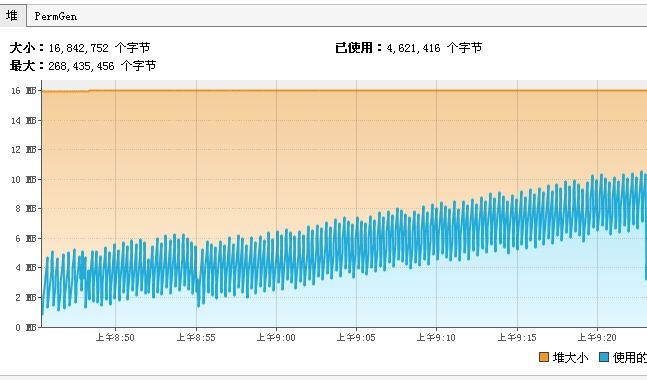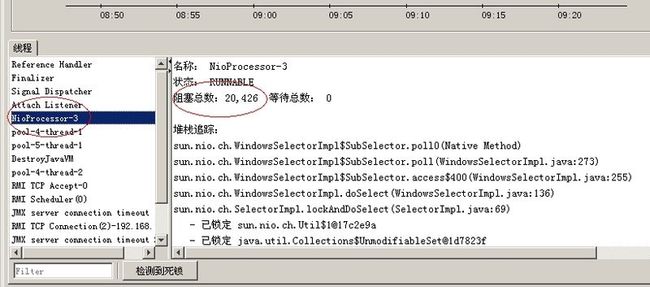MINA2的多线程模型问题探讨
最近和一友人沟通,他在一个项目中使用MINA2,他反馈在启动了服务端之后,发现IO阻塞和堆内存一直上升;


JCONSOLE面板中的解释:
阻塞总数
Blocked count is the total number of times that the thread blocked to enter or reenter a monitor. I.e. the number of times a thread has been in the java.lang.Thread.State.BLOCKED state.
当线程试图获取一个内部的对象锁(不是java.util.concurrent库中的锁),而锁被其它线程占有,则该线程进入阻塞状态。
等待总数
Waited count is the total number of times that the thread waited for notification. i.e. the number of times that a thread has been in the ava.lang.Thread.State.WAITING or java.lang.Thread.State.TIMED_WAITING state.
当线程等待另外一个线程通知调度器的一个条件的时候,它自己进入等待状态。在调用Object.wait()或Thread.join()方法,或者等待java.util.concurrent库中的Lock或Condition时,会出现等待状况。
后这两天我自己本地拿一个简单案例测试了下,
采用JAVA原生的newCachedThreadPool,以及MINA2自带的 OrderedThreadPoolExecutor 线程池,在性能上没有太大的区别;
本身他原来的代码中就是使用了一种线程池,将IO线程和工作线程(业务线程)区分开的,所以这个处理的堆内存升高和IO堵塞是正常现象,我本地代码实测,暂用的堆内存并不多,而且是快速回收了,并不影响后续业务;
下图中大量的thread就是由于使用了ExecutorFilter之后,MINA2服务器端产生的大量线程。

在服务端启动的代码中有一段如下:
仔细研究了下JCONSOLE中的阻塞总数,结合本地运行的经验,下图的结果:

根据图里面的信息,发现在NioProcessor.java中
@Override
protected int select(long timeout) throws Exception {
return selector.select(timeout);
}
然后继续跟踪,在AbstractPollingIoProcessor.java类中
上述行发生了阻塞行为,这个类是干嘛的呢?这个类是MINA2中去轮训SELECTOR中是否有空闲的,查看一下selector的源码:
仔细的看看注释:
Selects a set of keys whose corresponding channels are ready for I/O[color=red][/color]
原来是去轮训IO通道是否空闲,也就是说上述阻塞是发生在这里,也就是说IO通道被轮训发生的阻塞,所以说本文开头的阻塞数量是这样产生的:
当大量的并发消息过来,MINA2服务端需要轮训IO通道是否OK,OK之后就马上交给工作线程(如果有)去处理。所以从上面看来,这个是正常现象。在同时并发大量消息的时候,MINA2的IO通道还是会有堵塞。
另外:
我们知道:MINA2采用的是责任链模式,在处理过程中插入不同的filter,来进行不同的处理。
当服务器端启动的时候,会启动默认的I0线程,也就是主线程,MINA2建议是CPU数量+1,如果代码中不增加上述一行,那么如果加入上述的ExecutorFilter之后,工作线程将会和IO线程分开,简单的例子,如果你要发一些消息给服务端,要服务端提交一个事务,如果不采用ExecutorFilter,那么IO线程就会一直等待这个事务结束,才会接着处理下一个任务,否则一直等待,如果采用了ExecutorFilter,那么IO线程会将任务交给ExecutorFilter的线程池,由线程池去处理事务,而IO线程就释放了,这样IO线程非常高效的能够同时处理很多的并发任务。
用new ExecutorFilter(),缺省使用OrderedThreadPoolExecutor线程池。需要注意的是这个线程池,对应同一个session而言,是顺序执行的.也就是说mina2里面的message处理都是顺序的,不会说出现在消息没有接受完毕之前关闭。
常见的也有这样的处理:修改成:
然


JCONSOLE面板中的解释:
阻塞总数
Blocked count is the total number of times that the thread blocked to enter or reenter a monitor. I.e. the number of times a thread has been in the java.lang.Thread.State.BLOCKED state.
当线程试图获取一个内部的对象锁(不是java.util.concurrent库中的锁),而锁被其它线程占有,则该线程进入阻塞状态。
等待总数
Waited count is the total number of times that the thread waited for notification. i.e. the number of times that a thread has been in the ava.lang.Thread.State.WAITING or java.lang.Thread.State.TIMED_WAITING state.
当线程等待另外一个线程通知调度器的一个条件的时候,它自己进入等待状态。在调用Object.wait()或Thread.join()方法,或者等待java.util.concurrent库中的Lock或Condition时,会出现等待状况。
后这两天我自己本地拿一个简单案例测试了下,
采用JAVA原生的newCachedThreadPool,以及MINA2自带的 OrderedThreadPoolExecutor 线程池,在性能上没有太大的区别;
本身他原来的代码中就是使用了一种线程池,将IO线程和工作线程(业务线程)区分开的,所以这个处理的堆内存升高和IO堵塞是正常现象,我本地代码实测,暂用的堆内存并不多,而且是快速回收了,并不影响后续业务;
下图中大量的thread就是由于使用了ExecutorFilter之后,MINA2服务器端产生的大量线程。

在服务端启动的代码中有一段如下:
filterChainBuilder.addLast("threadPool", new ExecutorFilter());
仔细研究了下JCONSOLE中的阻塞总数,结合本地运行的经验,下图的结果:

根据图里面的信息,发现在NioProcessor.java中
@Override
protected int select(long timeout) throws Exception {
return selector.select(timeout);
}
然后继续跟踪,在AbstractPollingIoProcessor.java类中
private class Processor implements Runnable {
public void run() {
assert (processorRef.get() == this);
int nSessions = 0;
lastIdleCheckTime = System.currentTimeMillis();
for (;;) {
try {
// This select has a timeout so that we can manage
// idle session when we get out of the select every
// second. (note : this is a hack to avoid creating
// a dedicated thread).
long t0 = System.currentTimeMillis();
int selected = select(SELECT_TIMEOUT);
long t1 = System.currentTimeMillis();
long delta = (t1 - t0);
if ((selected == 0) && !wakeupCalled.get() && (delta < 100)) {
// Last chance : the select() may have been
// interrupted because we have had an closed channel.
if (isBrokenConnection()) {
LOG.warn("Broken connection");
// we can reselect immediately
// set back the flag to false
wakeupCalled.getAndSet(false);
continue;
} else {
LOG.warn("Create a new selector. Selected is 0, delta = "
+ (t1 - t0));
// Ok, we are hit by the nasty epoll
// spinning.
// Basically, there is a race condition
// which causes a closing file descriptor not to be
// considered as available as a selected channel, but
// it stopped the select. The next time we will
// call select(), it will exit immediately for the same
// reason, and do so forever, consuming 100%
// CPU.
// We have to destroy the selector, and
// register all the socket on a new one.
registerNewSelector();
}
// Set back the flag to false
wakeupCalled.getAndSet(false);
// and continue the loop
continue;
}
// Manage newly created session first
nSessions += handleNewSessions();
updateTrafficMask();
// Now, if we have had some incoming or outgoing events,
// deal with them
if (selected > 0) {
//LOG.debug("Processing ..."); // This log hurts one of the MDCFilter test...
process();
}
// Write the pending requests
long currentTime = System.currentTimeMillis();
flush(currentTime);
// And manage removed sessions
nSessions -= removeSessions();
// Last, not least, send Idle events to the idle sessions
notifyIdleSessions(currentTime);
// Get a chance to exit the infinite loop if there are no
// more sessions on this Processor
if (nSessions == 0) {
processorRef.set(null);
if (newSessions.isEmpty() && isSelectorEmpty()) {
// newSessions.add() precedes startupProcessor
assert (processorRef.get() != this);
break;
}
assert (processorRef.get() != this);
if (!processorRef.compareAndSet(null, this)) {
// startupProcessor won race, so must exit processor
assert (processorRef.get() != this);
break;
}
assert (processorRef.get() == this);
}
// Disconnect all sessions immediately if disposal has been
// requested so that we exit this loop eventually.
if (isDisposing()) {
for (Iterator<S> i = allSessions(); i.hasNext();) {
scheduleRemove(i.next());
}
wakeup();
}
} catch (ClosedSelectorException cse) {
// If the selector has been closed, we can exit the loop
break;
} catch (Throwable t) {
ExceptionMonitor.getInstance().exceptionCaught(t);
try {
Thread.sleep(1000);
} catch (InterruptedException e1) {
ExceptionMonitor.getInstance().exceptionCaught(e1);
}
}
}
try {
synchronized (disposalLock) {
if (disposing) {
doDispose();
}
}
} catch (Throwable t) {
ExceptionMonitor.getInstance().exceptionCaught(t);
} finally {
disposalFuture.setValue(true);
}
}
}
上述行发生了阻塞行为,这个类是干嘛的呢?这个类是MINA2中去轮训SELECTOR中是否有空闲的,查看一下selector的源码:
/**
[color=red][b] * Selects a set of keys whose corresponding channels are ready for I/O
* operations.
*
* <p> This method performs a blocking <a href="#selop">selection
* operation</a>. It returns only after at least one channel is selected,
* this selector's {@link #wakeup wakeup} method is invoked, the current
* thread is interrupted, or the given timeout period expires, whichever
* comes first.
*
* <p> This method does not offer real-time guarantees: It schedules the
* timeout as if by invoking the {@link Object#wait(long)} method. </p>[/b][/color]
*
* @param timeout If positive, block for up to <tt>timeout</tt>
* milliseconds, more or less, while waiting for a
* channel to become ready; if zero, block indefinitely;
* must not be negative
*
* @return The number of keys, possibly zero,
* whose ready-operation sets were updated
*
* @throws IOException
* If an I/O error occurs
*
* @throws ClosedSelectorException
* If this selector is closed
*
* @throws IllegalArgumentException
* If the value of the timeout argument is negative
*/
public abstract int select(long timeout)
throws IOException;
仔细的看看注释:
Selects a set of keys whose corresponding channels are ready for I/O[color=red][/color]
原来是去轮训IO通道是否空闲,也就是说上述阻塞是发生在这里,也就是说IO通道被轮训发生的阻塞,所以说本文开头的阻塞数量是这样产生的:
当大量的并发消息过来,MINA2服务端需要轮训IO通道是否OK,OK之后就马上交给工作线程(如果有)去处理。所以从上面看来,这个是正常现象。在同时并发大量消息的时候,MINA2的IO通道还是会有堵塞。
另外:
我们知道:MINA2采用的是责任链模式,在处理过程中插入不同的filter,来进行不同的处理。
当服务器端启动的时候,会启动默认的I0线程,也就是主线程,MINA2建议是CPU数量+1,如果代码中不增加上述一行,那么如果加入上述的ExecutorFilter之后,工作线程将会和IO线程分开,简单的例子,如果你要发一些消息给服务端,要服务端提交一个事务,如果不采用ExecutorFilter,那么IO线程就会一直等待这个事务结束,才会接着处理下一个任务,否则一直等待,如果采用了ExecutorFilter,那么IO线程会将任务交给ExecutorFilter的线程池,由线程池去处理事务,而IO线程就释放了,这样IO线程非常高效的能够同时处理很多的并发任务。
用new ExecutorFilter(),缺省使用OrderedThreadPoolExecutor线程池。需要注意的是这个线程池,对应同一个session而言,是顺序执行的.也就是说mina2里面的message处理都是顺序的,不会说出现在消息没有接受完毕之前关闭。
常见的也有这样的处理:修改成:
filterChainBuilder.addLast("threadPool", new ExecutorFilter(Executors.newCachedThreadPool
());
然